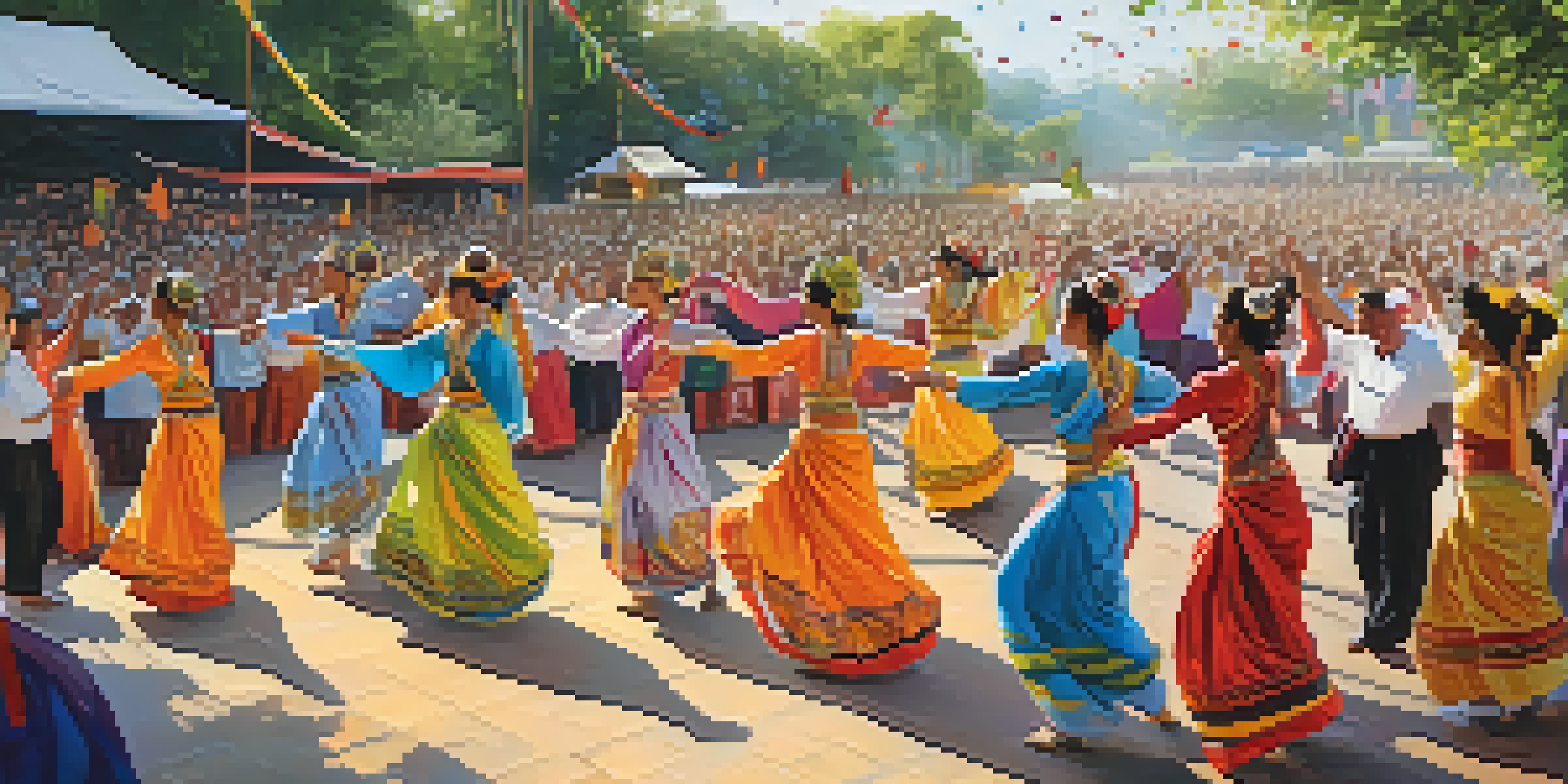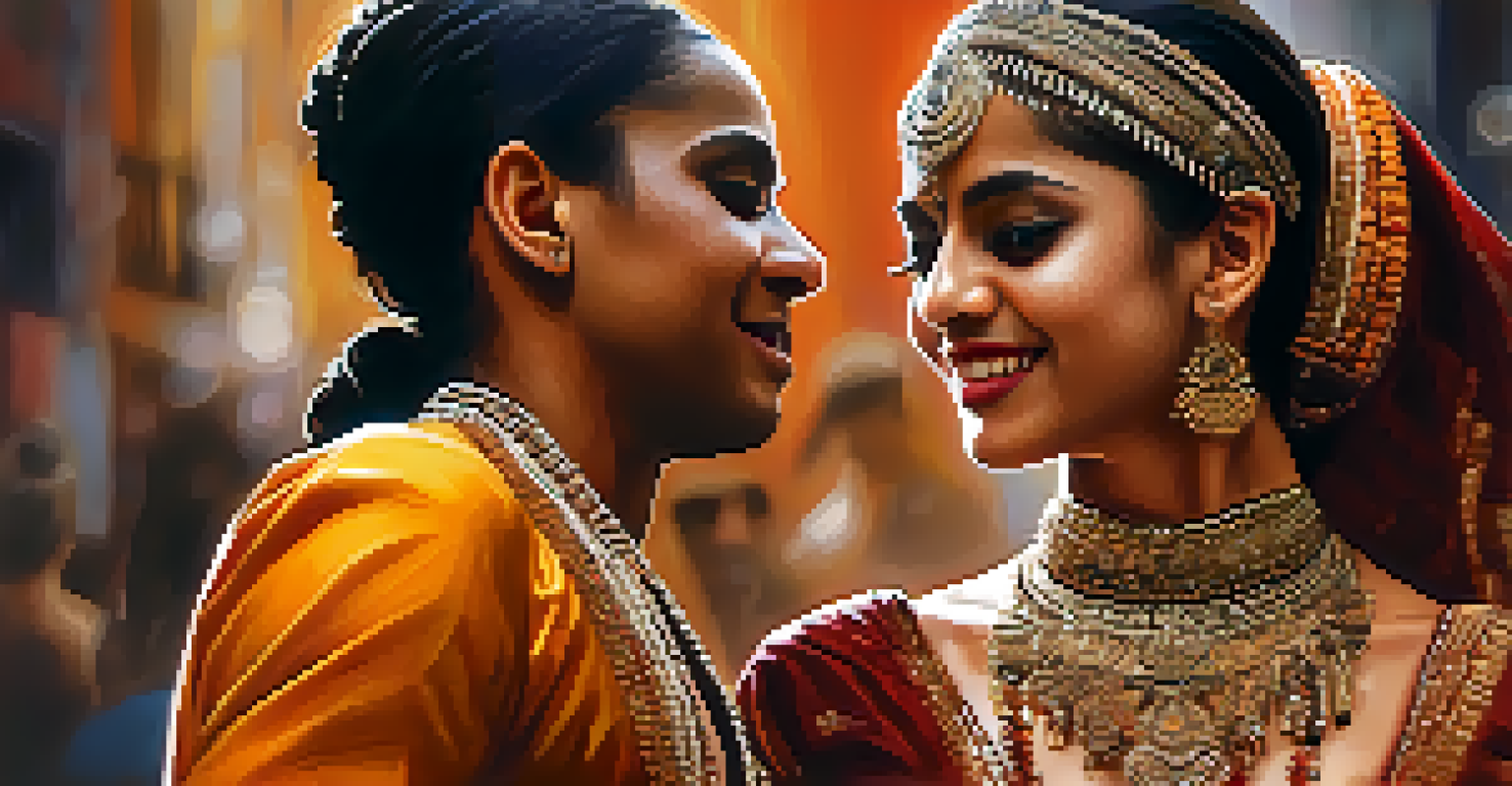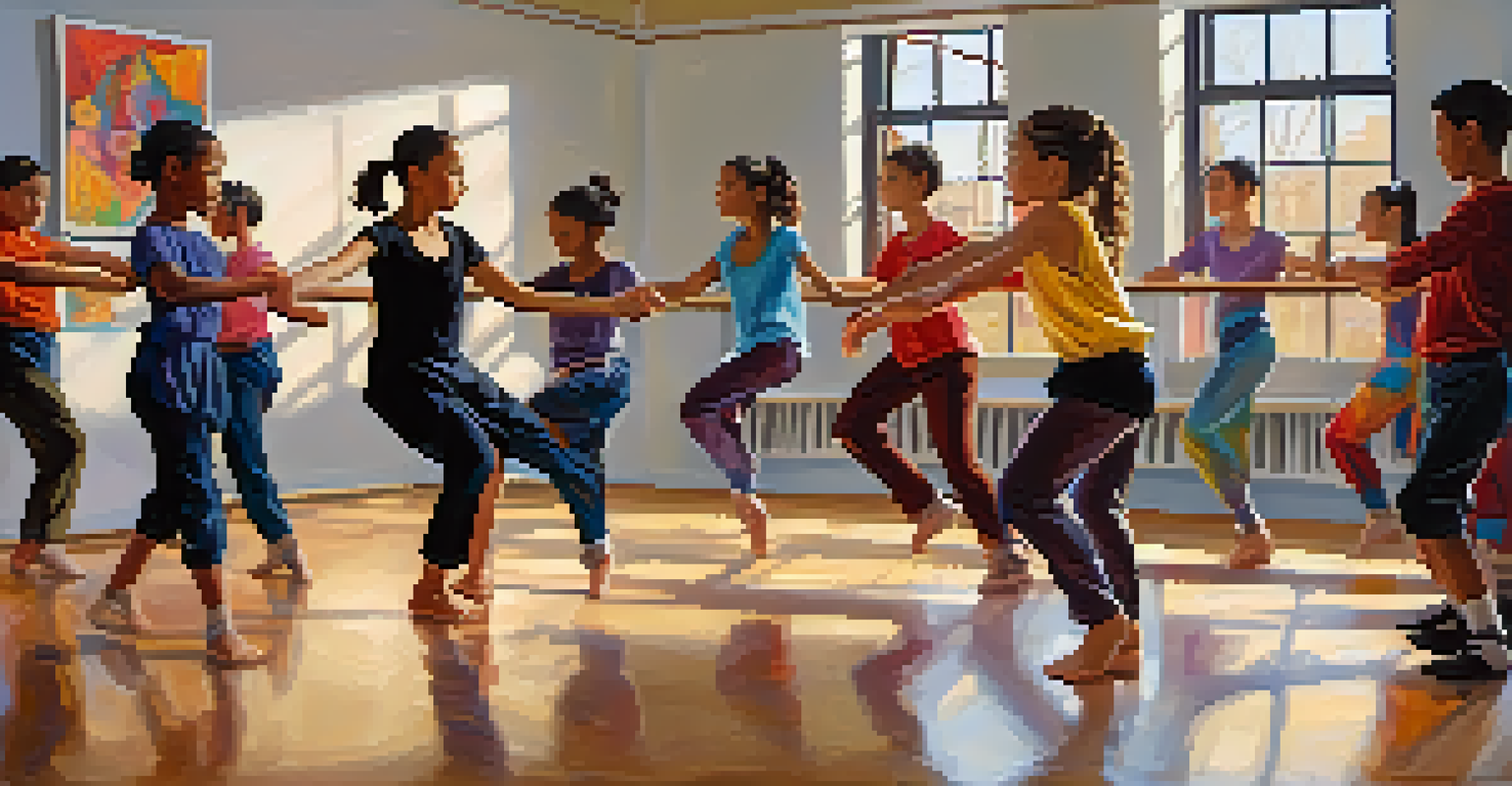Cultural Exchanges in Dance Collaborations: A Global Perspective

Understanding Cultural Exchanges Through Dance
Cultural exchanges in dance are about more than just movement; they involve sharing stories, traditions, and emotions. Dance serves as a universal language that breaks barriers, allowing diverse cultures to connect on a deeper level. For instance, a traditional Indian Bharatanatyam dance might blend with contemporary hip-hop, creating a fusion that speaks to both heritage and modernity. Such collaborations not only celebrate diversity but also enrich the artistic landscape by introducing new techniques and perspectives.
Dance is the hidden language of the soul.
Moreover, these exchanges often lead to the creation of new dance forms that reflect a blend of cultural influences. Think of how the tango evolved in the streets of Buenos Aires, incorporating elements from African, European, and indigenous dances. This continuous evolution showcases how cultural exchanges facilitate growth and innovation in the art of dance. Ultimately, they remind us that creativity knows no borders.
As artists engage in these collaborations, they foster mutual respect and understanding, which are essential in today's global society. Such interactions encourage empathy and awareness of different cultural narratives, allowing dancers to become ambassadors of their heritage. By participating in cultural exchanges, they contribute to a shared human experience that transcends geographical and social boundaries.
The Role of Festivals in Dance Collaborations
Dance festivals around the world serve as vibrant platforms for cultural exchanges. Events like the Edinburgh International Festival or the Jacob's Pillow Dance Festival showcase an array of dance styles from various cultures, inviting artists to collaborate and perform together. These festivals often feature workshops, discussions, and performances that promote learning and sharing among participants. This setting allows dancers to experiment with new styles while gaining insights from their peers.

Additionally, festivals create a sense of community among artists and audiences alike. When dancers from different backgrounds come together, they not only share their art but also their stories, fostering connections that can last a lifetime. For example, the DanceAfrica festival in Brooklyn celebrates African dance and culture, encouraging artists from the African diaspora to collaborate and showcase their traditions. Such events highlight the importance of cultural pride while promoting cross-cultural dialogue.
Dance Fosters Cultural Connections
Cultural exchanges in dance create a universal language that enables diverse cultures to share stories and traditions.
Moreover, these festivals can have a lasting impact on local communities by inspiring future generations of dancers. When young aspiring artists witness these cultural exchanges, they are often motivated to explore their own heritage and learn about others. This cycle of inspiration and collaboration ensures that the rich tapestry of global dance continues to evolve, reflecting the diverse world we live in.
Case Studies of Successful International Collaborations
Examining successful international dance collaborations reveals the potential of cultural exchanges. A prime example is the partnership between the Alvin Ailey American Dance Theater and various African dance companies. Their joint performances not only highlight the beauty of African dance but also emphasize its influence on contemporary American styles. By merging these artistic approaches, they create a unique experience that resonates with audiences from both cultures.
The dance is a poem of which each movement is a word.
Another noteworthy collaboration is between the Royal Ballet and dancers from India, which resulted in the stunning production of 'The Nutcracker' infused with classical Indian dance elements. This blend showcases how traditional and contemporary styles can coexist, resulting in a fresh narrative that appeals to a wider audience. Such collaborations demonstrate the power of creativity in bridging cultural divides.
These case studies illustrate that successful dance collaborations often require a willingness to learn and adapt. Dancers must embrace vulnerability and be open to new experiences, which can lead to remarkable artistic outcomes. By sharing their distinct movements and techniques, they not only enrich their own practice but also contribute to a global conversation about the significance of cultural diversity in the arts.
Dance as a Tool for Social Change
Dance has long been recognized as a powerful tool for social change, and cultural exchanges amplify this potential. Through collaboration, artists can address pressing social issues while celebrating their cultural identities. For instance, projects like 'Dancing in the Streets' use dance to raise awareness about community struggles, fostering solidarity among diverse groups. When artists unite, their collective voice becomes a catalyst for change.
Moreover, cultural exchanges allow for the exploration of themes such as identity, migration, and belonging. Dance companies often engage in projects that reflect the experiences of marginalized communities, bridging gaps through shared narratives. This approach not only empowers the artists involved but also resonates with audiences, inviting them to reflect on their own cultural experiences. The act of dancing together becomes a form of resistance and resilience.
Festivals Promote Collaboration
Dance festivals serve as vibrant platforms that encourage artists from various backgrounds to collaborate and share their art.
Ultimately, the impact of these collaborations extends beyond the stage. They inspire dialogue and encourage communities to come together, promoting understanding and empathy. As audiences witness these powerful stories through dance, they are reminded of our shared humanity, fostering a more inclusive and compassionate society.
Training and Education in Global Dance Practices
Training and education play a crucial role in facilitating cultural exchanges in dance. Dance institutions worldwide are increasingly incorporating diverse global styles into their curricula, allowing students to explore various traditions. For instance, programs that teach both ballet and African dance encourage students to appreciate the richness of different cultures while honing their technical skills. This exposure not only broadens their artistic capabilities but also nurtures open-mindedness.
Moreover, workshops and exchange programs enable dancers to learn directly from international artists. By participating in these immersive experiences, they gain insights into unique techniques and cultural contexts. For example, a dancer studying traditional Japanese butoh may find their contemporary style enriched by this ancient practice. These learning opportunities foster respect for different dance forms and encourage collaboration among artists from various backgrounds.
In this way, education becomes a bridge that connects cultures through dance. As students engage with global practices, they develop a sense of responsibility to honor and preserve these traditions. Ultimately, this commitment to cultural understanding prepares the next generation of dancers to contribute meaningfully to the ongoing dialogue of dance as a form of cultural exchange.
Challenges and Opportunities in Cultural Exchanges
While cultural exchanges in dance offer immense opportunities, they also present certain challenges. One significant hurdle is the risk of cultural appropriation, where elements of a culture are adopted without proper understanding or respect. Dancers and artists must navigate this delicate terrain, ensuring that their collaborations honor the traditions from which they draw inspiration. Open dialogue and mutual respect are essential in addressing these concerns.
Additionally, logistical barriers such as funding and access to resources can hinder collaborations. Many artists struggle to secure financial support for international projects, which can limit their ability to connect with diverse cultures. However, these challenges often lead to creative solutions, such as community fundraising or digital collaborations, enabling artists to share their work across borders. The resilience of the dance community in overcoming these obstacles is a testament to their dedication to cultural exchange.
Education Bridges Global Practices
Training in diverse dance styles fosters appreciation and respect for different cultures, preparing dancers for meaningful collaborations.
Ultimately, recognizing and addressing these challenges can lead to more meaningful collaborations. When artists approach cultural exchanges with sensitivity and awareness, they can create work that resonates deeply with audiences. By embracing both the challenges and opportunities, the dance community can continue to thrive while fostering a rich tapestry of global cultural exchange.
The Future of Cultural Exchanges in Dance
The future of cultural exchanges in dance is bright, driven by an increasing interest in global collaboration. As technology continues to evolve, artists are finding new ways to connect and share their work. Virtual performances and online workshops enable dancers from different parts of the world to collaborate without the constraints of geography. This accessibility opens doors to innovative exchanges that were previously unimaginable.
Moreover, as awareness of cultural diversity grows, more artists are recognizing the importance of inclusivity in their work. Future collaborations are likely to prioritize representation and authenticity, ensuring that diverse voices are heard and celebrated. For example, dancers may seek to co-create performances that reflect a multitude of perspectives, creating a richer narrative that resonates with audiences on a global scale.

As we look ahead, the potential for cultural exchanges in dance is limitless. By continuing to embrace collaboration and innovation, the dance community can contribute to a deeper understanding of cultures, fostering empathy and unity. This journey of exploration and creativity ensures that dance remains a vital force for cultural exchange in an ever-changing world.